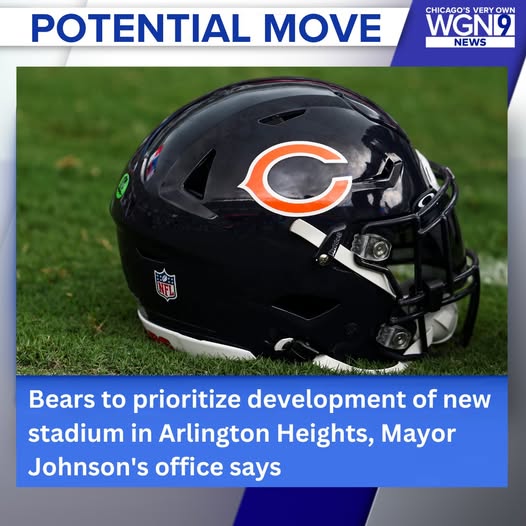
The Chicago Bears, one of the NFL’s most storied franchises, appear to be setting their sights on a significant relocation that could reshape the future of the team and the fan experience. Rumors and reports have increasingly suggested that the Bears are seriously considering moving their operations and possibly their home games to the northwest suburbs of Chicago. This potential shift has sparked intense debate among fans, analysts, and local communities, highlighting both the challenges and opportunities that such a move would entail.
For decades, the Bears have been synonymous with the city of Chicago, a team deeply woven into the fabric of the city’s identity. Soldier Field, the historic stadium nestled along the shores of Lake Michigan, has been the Bears’ home since 1971. Its iconic location, just steps away from downtown Chicago, has made attending games a unique experience, combining the urban energy of the city with the passion of Bears fans. However, in recent years, questions about the stadium’s facilities, fan accessibility, and revenue potential have emerged, prompting team executives to explore alternative options.
The northwest suburbs, known for their sprawling communities, expansive parking, and growing population, have emerged as a prime candidate for the Bears’ next chapter. Suburbs such as Arlington Heights, Schaumburg, and Elk Grove Village have been mentioned as potential locations due to their proximity to major highways, ample land availability, and economic incentives offered by local governments eager to attract a franchise of this caliber. Such a move could dramatically change the logistics of attending games, with easier access for suburban fans who currently face lengthy commutes into downtown Chicago.
From a business perspective, the shift to the suburbs offers numerous advantages. Modern stadiums built in suburban areas have the potential to generate significantly higher revenues through state-of-the-art facilities, luxury suites, and mixed-use developments that combine retail, entertainment, and dining. These amenities are crucial in today’s NFL landscape, where franchises compete fiercely to maximize their income streams both on and off the field. The Bears’ current home at Soldier Field, while rich in history, lacks many of these modern revenue-generating features. A new suburban stadium could position the franchise financially to better compete in the league’s increasingly competitive market.
The move would also align with trends seen across professional sports, where teams have opted to build new stadiums or relocate to suburban areas offering greater financial incentives and more control over their venues. Examples include the Los Angeles Rams’ new stadium in Inglewood and the Dallas Cowboys’ stadium in Arlington, Texas. These stadiums have become landmarks not only for football but for entertainment and social gathering, creating year-round hubs for fans and residents alike. The Bears could replicate such a model in the northwest suburbs, helping to revitalize local economies and attract visitors beyond game days.
However, the prospect of relocating away from downtown Chicago is not without its critics. Many Bears fans feel a deep emotional connection to Soldier Field and the city itself, viewing the stadium as more than just a venue but as a symbol of the team’s legacy and history. For these fans, moving to the suburbs risks alienating a loyal urban fan base and diminishing the unique cultural experience that comes with attending games in the heart of Chicago. The Bears have long been seen as a quintessential Chicago team, and detaching from the city’s core could lead to backlash or a loss of identity.
Transportation is another significant consideration. While suburban stadiums typically offer better parking and road access, they often lack the robust public transit options that urban stadiums provide. Soldier Field is easily accessible via Chicago’s public transit system, including buses and trains, allowing fans from all over the city and beyond to attend games without relying solely on cars. The northwest suburbs do not currently have the same level of transit infrastructure, which could pose challenges for fans who do not drive or prefer to avoid traffic congestion.
The economic impact on downtown Chicago is another factor that cannot be overlooked. Game days bring thousands of visitors who contribute to local businesses, including restaurants, bars, hotels, and retail shops. The Bears’ move to the suburbs could significantly reduce this influx of customers, affecting the city’s economy and the vibrancy of neighborhoods surrounding Soldier Field. This potential loss has raised concerns among city officials and business owners who rely on game day crowds for substantial portions of their revenue.
Despite these concerns, there are signs that the Bears organization is committed to ensuring a smooth transition if a move to the northwest suburbs is finalized. Team executives have reportedly been engaging with community leaders, transportation planners, and urban developers to address potential challenges and create solutions that benefit both fans and the local population. Plans for enhanced transit options, shuttle services, and improved roadways are being considered to maintain accessibility and convenience.
Community impact will also be a crucial component of any new stadium project. Modern stadium developments often include community spaces, parks, and facilities designed to serve residents year-round, not just on game days. By incorporating these elements, the Bears could foster stronger relationships with suburban communities and create a new sense of place and pride around their new home. Additionally, partnerships with local schools, charities, and organizations could ensure the team remains an integral part of the broader Chicago-area community, regardless of location.
From a competitive standpoint, a new stadium and training facilities in the suburbs could provide the Bears with cutting-edge resources to attract and develop top talent. State-of-the-art practice facilities, medical centers, and player amenities are increasingly important factors for NFL teams looking to build winning rosters. The Bears’ ability to upgrade their infrastructure could improve player satisfaction, reduce injuries, and enhance overall team performance.
The timing of this potential move is also noteworthy. The NFL is undergoing rapid changes with evolving business models, media rights deals, and fan engagement strategies. Franchises that can adapt quickly and invest in modern facilities are better positioned to thrive in this dynamic environment. The Bears’ willingness to consider relocating indicates a proactive approach to securing their future competitiveness both on and off the field.
Of course, no official announcement has been made, and the Bears are likely weighing all options carefully. The decision to relocate or build a new stadium is complex, involving numerous stakeholders, financial considerations, and potential political hurdles. Public opinion, fan loyalty, and the legacy of the franchise are also critical factors that will influence the final outcome.
As news of the Bears’ interest in the northwest suburbs continues to circulate, the conversation about the team’s future has expanded beyond the gridiron. It has sparked discussions about urban development, transportation, economic impact, and what it means to be a Chicago sports franchise in the 21st century. Fans are debating whether a move would represent progress or a loss of tradition. Local officials are evaluating how best to leverage the opportunity for regional growth. And the Bears organization is navigating the delicate balance between honoring its storied past and embracing a bold new future.
Whatever the final decision, one thing is clear: the Chicago Bears are at a crossroads. The possibility of moving to the northwest suburbs marks a pivotal moment in the franchise’s history, one that could redefine its identity, fan experience, and competitive edge for years to come. Whether this move ultimately happens or not, it signals that the Bears are thinking strategically about their place in the NFL landscape and the evolving needs of their fans and community.
The Bears’ potential move to the northwest suburbs is emblematic of broader trends in professional sports, where teams seek to maximize revenue, improve facilities, and better serve their fans through strategic location choices. It underscores the challenges that historic franchises face in balancing tradition with modernization. For the Bears, this decision is not just about where they play football—it is about where the franchise is headed as an institution and how it will continue to engage and inspire the next generation of supporters.
As the story develops, all eyes will be on the Bears’ leadership, fans, and local communities to see how this bold franchise shift unfolds. Will the Bears’ new home in the northwest suburbs become a beacon of innovation and success? Or will the team find its greatest strength remains in the heart of Chicago? Only time will tell, but the journey toward this decision will undoubtedly be one of the most consequential chapters in Chicago Bears history.







